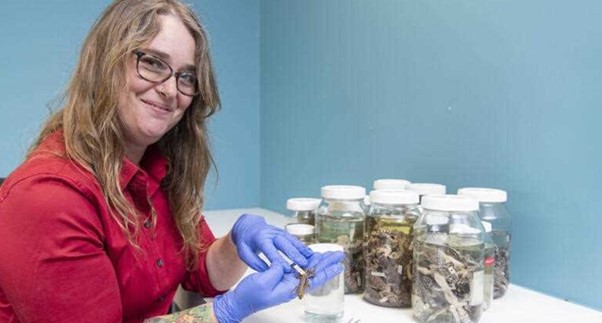
Dr Danielle Edwards from the Museum and Art Gallery of the Northern Territory with the Ctenophorus ibiri lizard found on the Eyre Peninsula.
Image: AAP Image/Supplied by Museum & Art Gallery of the NT, Mark Sherwood
Four species of sand dragon lizards native to southern Australia have been found and named using traditional languages of the country on which they were discovered.
When two Australian researchers came across unclassified species of sand dragon lizard, instead of following the tradition of using Greek or Latin terms to name them, they turned to ancient languages from their own country.
Danielle Edwards and Mark Hutchinson found four species of sand dragons in southern Australia, including the Eyre Peninsula and River Murray, and consulted traditional owners on appropriate names.
The dry and sandy southern lands provide habitat for little sand-coloured lizards that race away when disturbed.
Many of these reptiles belong to one particular group of small dragon lizards, no more than 20 cm long, and they are the less-spiny relatives of the bearded dragon and frilled lizard.
But 10 years ago, Dr Edwards, a curator at the Museum and Art Gallery of the Northern Territory, began genetic and ecological studies on these lizards and found there were probably many more than the three species recognised at the time.

The Ctenophorus ibiri is derived from the Dieri language and found on the Eyre Peninsula. Image: Peter Tremul
WHAT'S IN A NAME?
Ctenophorus tjakalpa: Named after its traditional moniker in the Great Victoria Desert, where it lives.
Ctenophorus ibiri: Derived from the Barngala language term meaning "ibiri," which denotes a small lizard. This species inhabits parts of the Eyre Peninsula.
Ctenophorus kartiwarru: Derived from the Dieri language term "kartiwarru", which refers to a red-backed lizard found in the region.
Ctenophorus tuniluki: Composed of the Ngarrindjeri language words "tuni" (sand) and "luki" (lizard). This species is found in habitats along the southern Murray River.
This prompted her to join forces with Dr Hutchinson, an honorary researcher at the South Australian Museum who previously worked with the Maralinga Tjarutja people of the Great Victoria Desert.
“We consulted them to ask what they called the lizards we were describing so we could name them using a traditional language,” Dr Edwards said.
“They conferred to us that the small dragon lizards living in the dunes were called ‘tjakalpa’, so we named this species Ctenophorus tjakalpa as it overlapped with this language group in distribution.
“Other language names were derived from published traditional language accounts.”
The duo’s research concluded there were 11 species within this particular group of sand dragon lizard, four of which were newly discovered.
Indigenous terms were used to name the lizards to highlight the importance of first languages and knowledge, and collaboration with their custodians.
All of the sand dragon lizards are found in South Australia within a particular landscape – the dunes of the Great Victoria Desert, the Simpson Desert and the semi-arid sandy mallee of the Eyre Peninsula and SA-Victoria border.
– AAP


